Researches
■Fabrication of CuCl Single Crystals and Quantum Dots
|
CuCl is a wide-gap semiconductor and an appropriate material for the study of fundamental light-matter interaction related to an exciton, an electron-hole pair combined through Coulomb interaction, because the exciton in CuCl has a large binding energy. In addition, CuCl quantum dots (QDs) show typical properties of the weak confinement regime, in which the center-of-mass motion of the exciton is quantized because of the small exciton effective Bohr radius. We have fabricated CuCl single crystals by means of the vapor transport method, and CuCl QDs embedded in a NaCl matrix by means of the transverse Bridgman method. The CuCl single crystal has been used for experiments on the excited states of the exciton and biexciton and on generation of entangled photon pairs due to the polariton?polariton scattering process. In addition, we have examined the fabrication of the QDs with quite high density in order to generate superfluorescence by coherent interaction among the excited QDs. |
 Crystal structure of CuCl |
■Coherent Interaction between Semiconductor Quantum Dots Assembly
|
When many excited two-level systems interacts with an identified electromagnetic field, the radiative time becomes shorter as a function of the number of two-level systems. In particular, complete population inversion, i.e., the condition that all the two-level systems are excited, results in a pulsed emission. This emission has peak intensity and pulse width proportional to N2 and 1/N respectively, where N is the number of two-level systems. This phenomenon was first predicted by Dicke as superradiance, and it was mainly reported for an ensemble of atoms and molecules in the 1980s. In these reports, the macroscopic dipole moment is spontaneously formed by coherent interaction among individual dipole moments, which is triggered by fluorescence. Then, the macroscopic dipole moment radiates pulsed emission. Therefore, this phenomenon was termed ″superfluorescence.″ We have examined the mechanism for generating superfluorescence in semiconductor QDs. We have reported the generation of superfluorescence from biexcitons for CuCl QDs by achieving complete population inversion between the biexciton and exciton levels using resonant two-photon excitation of the biexcitons. Moreover, we have tried to generate superfluorescence with the pulse width shorter than that of atoms and molecules, and studied the specific mechanism of generating superfluorescence from the QDs. Superfluorescence from semiconductor QDs can be applied to an ultrashort coherent pulse source. In addition, spontaneous formation of macroscopic coherence is an attractive subject in condensed matter photophysics. We have fabricated CuCl QDs with high density and have measured time-resolved photoluminescence spectra by means of Kerr-gate spectroscopy in order to observe time profiles of the biexcitons photoluminescence. |
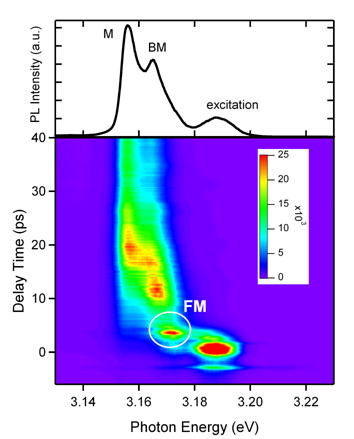 Pulsed emission of superfluorescence (FM) from biexcitons in CuCl QDs |
■Rydberg Excited States of Excitons and Biexcitons by Infrared Transient Absorption Spectra
|
An exciton has hydrogen-like Rydberg energy levels. Most reports on the exciton’s optical properties have mainly focused on the lowest 1s state. On the other hand, there have been few studies on the transition processes associated with internal levels of the exciton, that is, the transitions from the lowest 1s state to higher excited states, e.g., the 2p state. In addition, it is suggested that biexcitons have energy levels similar to that of a hydrogen molecule. In the case of the biexcitons, there are many reports focusing on the lowest state, but the excited states have been ignored. We have measured the exited states of the excitons and biexcitons by using CuCl, which has large binding energies of the excitons and the biexcitons respectively. In particular, we can expect a generation of new excited states of the biexciton in the nanostructures because of the confinement effect on the two unresolved excitons. For this purpose, the systematic measurement of the bulk crystals and the dots is necessary. This research is significant because it will determine fundamental properties related to the detailed energy structures of the exciton and biexciton. In addition, it is expected that a new optical response originates in the mid-infrared region, and it has great advantages for infrared optical devices. For this research, we have performed pump-probe spectroscopy. The excitons and biexcitons are excited resonantly by the pump light, and then, the transient absorptions from the lowest state to the higher excited states were measured using the probe light. |
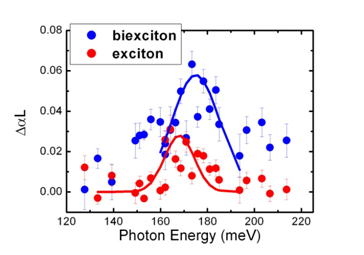 Infrared transition absorption spectra of biexcitons and excitons in CuCl crystals |
■Photo-induced Magnetization of Semimagnetic Semiconductor CdMnTe
|
A semimagnetic semiconductor, a semiconductor doped with magnetic ions, is an attractive material exhibiting optical properties influenced by spin interactions between the carriers and magnetic ions. In CdMnTe an exciton magnetic polaron, an exciton interacting with Mn ions through s,p-d exchange interaction, is formed. In addition, potential fluctuations due to inhomogeneous distribution of Mn ions in space results in localization of the excitons. That is, the optical properties are dominated by the localized exciton magnetic polarons. We observed an anomalous photoluminescence band, which appears only under selective excitation of localized excitons with high excitation density and strong nonlinearities in the excitation density. It suggests the possible existence of a high spin state of multi-exciton magnetic polarons. We focused on the appearance of giant photo-induced magnetization and optical properties of high-spin states of multi-exciton magnetic polarons. Therefore, we have measured the photoluminescence spectra and photo-induced magnetization of CdMnTe by means of time-resolved Faraday rotation and their excitation density dependencies and excitation energy dependencies. |
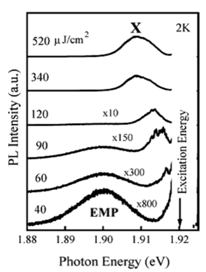 High spin state of multi-exciton magnetic polaron in CdMnTe |
■Optical Properties of SiC Nanostructures
|
Semiconductors with an indirect band-gap are generally not suitable for light-emitting devices because of their low radiative efficiency. However, the radiative efficiency is enhanced in the nanostructures of such materials. We paid attention to SiC, which is suitable for the applications to power devices, and we have studied the optical properties of its nanostructures. We observed properties of the photoluminescence spectra of porous amorphous SiC films. In addition, we examined photoluminescence of SiC nanotubes dispersed in polymers. We noted the mechanism of photoluminescence in SiC nanostructures, which involves quantized levels and surface states, and its possibility of being a new candidate in blue LED applications. |
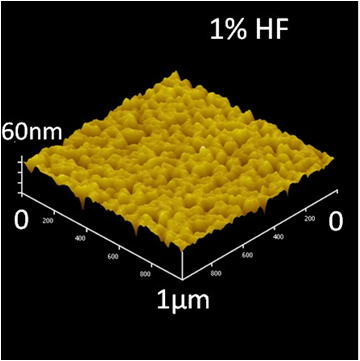 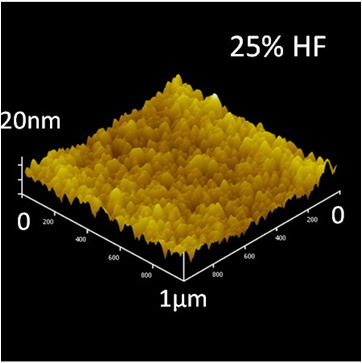 AFM images of porous amorphous SiC films |
Equipment
■Pulse Laser System for Wide Spectral Range
|
We have a high-intensity pulse laser system whose wavelength can be varied. It is applied to a variety of materials to excite resonantly the electronic states. We have performed pump-probe spectroscopies and the optical Kerr gate method by using this system. The system consists of a mode-locked Ti:sapphire laser, a regenerative amplifier, and optical parametric amplifiers. The pulsed light from the mode-locked Ti:sapphire laser (wavelength of 800 nm, pulse width of ~100 fs, repetition rate of 82 MHz) is amplified by the regenerative amplifier (pulse width of ~4 ps, the repetition rate of 1 kHz). The output pulse of the regenerative amplifier is split into two, and the two pulses enter two of the optical parametric amplifiers. In the optical parametric amplifiers, the wavelength can be split into two parts corresponding to the signal and idler beam which are both in the infrared range, using optical parametric conversion. In addition, the wavelength can be varied from 300 nm to 10000 nm by using a wavelength conversion method. One of the characteristics of our system is the narrow spectral width of the pulses. It is effective to reveal the detailed electric energy levels and dynamics for materials possessing a large inhomogeneous broadening, e.g., the quantum dot assembly or mixed crystal semiconductors. |
|
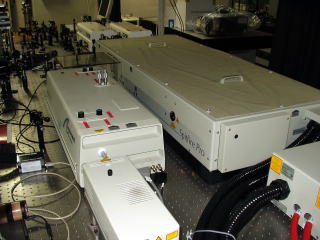 |
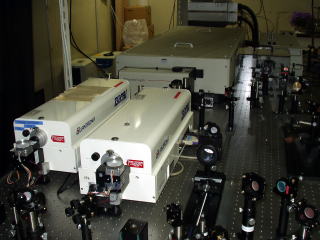 |
| Mode-locked Ti:sapphire laser and a regenerative amplifier | Two optical parametric amplifiers |
■Light Sources
| We used a diode-pumped solid state (DPSS) laser (355 nm) and a semiconductor laser (400nm) as excitation light sources for photoluminescence measurements. A Xe lamp was used as an excitation light source in combination with a monochromator. A He-Ne laser was used for beam alignment. |
■Cryostats
| Some optical measurements were performed at low temperatures in order to more clearly examine the electronic states. The samples were kept at a low temperature in the cryostat, and light was focused on the sample through the optical windows. | |
 |
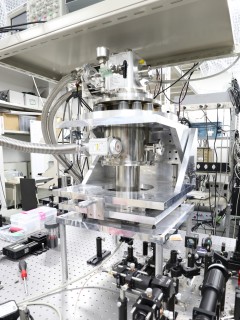 |
| Cryostat with four optical windows. Two of them are BaF2 windows for the infrared region | Cryostat with two optical windows |
■Sample Fabrication System
| Furnaces were used to fabricate CuCl single crystals and the quantum dots. | |
 |
 |
| Upper : the transverse Bridgman method Middle : the vapor phase transport method Lower : the zone melting method |
System including a vacuum pump and Ar gas |
■Spectrometers
| We measure the spectra by using spectrometers equipped with charge-coupled device (CCD) or photomultiplier (PMT). | |
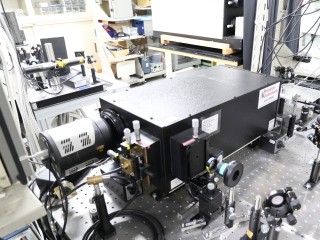 |
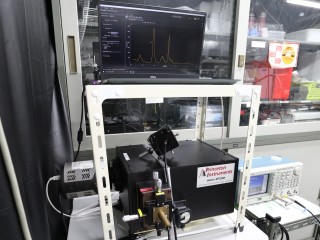 |
| Spectrometer with a focal length of 500 mm. It has two entrance ports, one of which is connected to the optical fiber, and two exit ports, one of which is connected to the CCD. | Spectrometer with a focal length of 300 mm. It has the entrance port connected to the optical fiber and two exit ports?one connected to the CCD and the other connected to the PMT. |
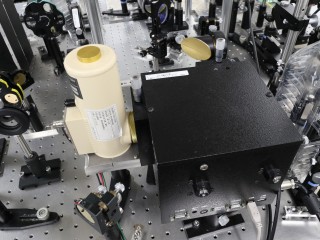 |
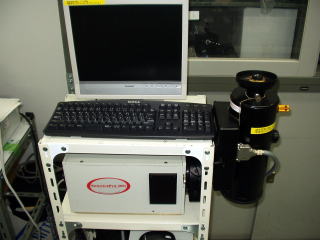 |
| Spectrometer with focal length of 150 mm. The grating for mid-infrared region is included. The MCT (HgCdTe) photodetector is set after the exit port. | Spectrometer with focal length of 300 mm. It has the entrance port connected to the optical fiber, and the exit port connected to the liquid N2-cooled CCD. |
■Optical Measurement Systems
| We construct experimental system for time-resolved spectroscopies. | |
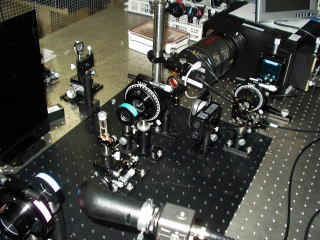 |
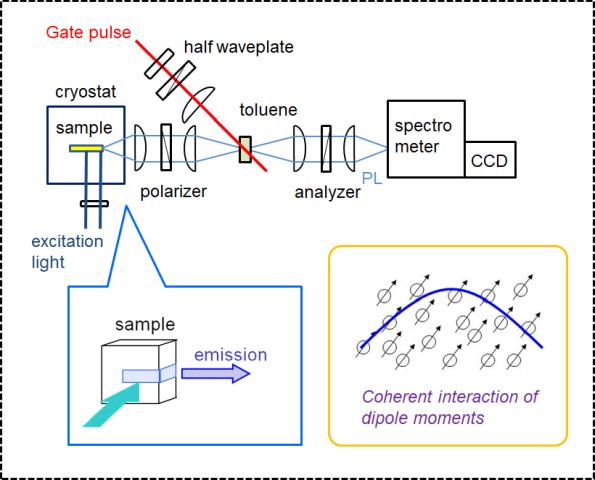 |
| Optical Kerr gate method to measure time-resolved photoluminescence spectra | |
 |
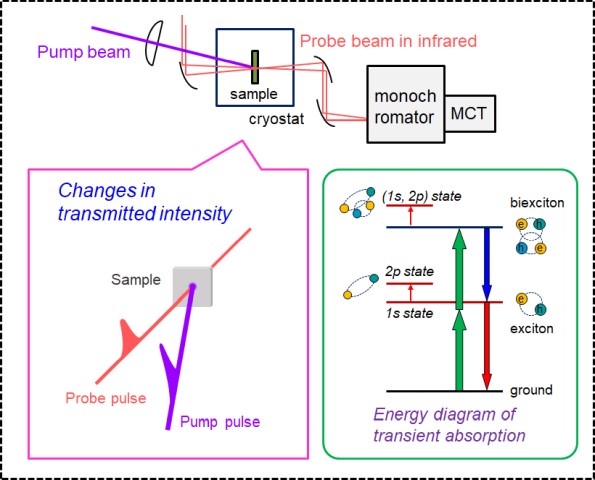
|
| Pump-probe spectroscopy to measure infrared transition absorption | |
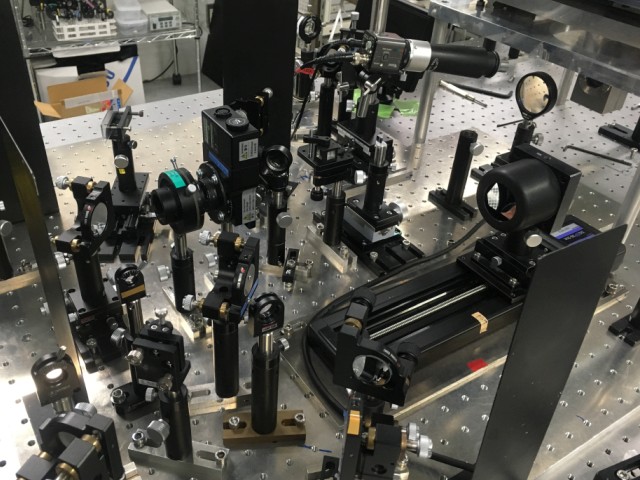 |
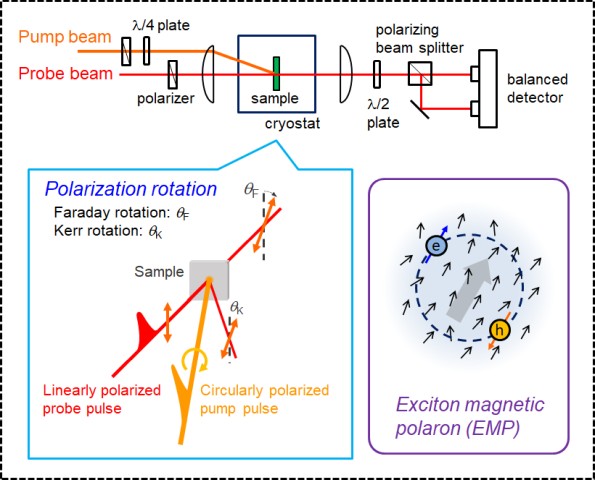
|
| Pump-probe spectroscopy to measure photo-induced Faraday rotation | |